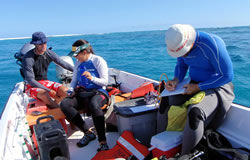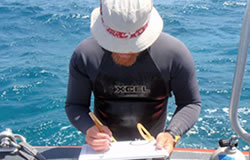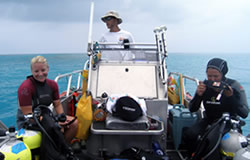2009 Expedition to Papahānaumokuākea Marine National Monument
A three-person maritime archaeology team conducted 16 days of survey in the NWHI in June of 2009. The team was part of a larger, 20-person scientific expedition to PMNM on the NOAA vessel Hiʻialakai that included work at Kure, Midway, Pearl and Hermes Atoll, French Frigate Shoals, and Laysan. Maritime archaeology was a "piggy-back" mission in 2009, which limited the team's access to daily boat space and time on site.
A primary objective of the 2009 maritime heritage mission was to support a Hawaiʻi Institute of Marine Biology graduate student, Derek Smith, as he began his thesis research to compare the biological community structure of maritime heritage sites to their surrounding habitat. In order to carry out this work, Smith, Ann Mooney (PMNM), and Monument maritime heritage coordinator and Principal Investigator Dr. Kelly Gleason conducted surveys at five shipwreck sites in the Monument over the course of sixteen days of diving in the Northwestern Hawaiian Islands. The team collected data about benthic community structure and substrate type, fish population, coral population genetics, and oceanographic information including temperature, salinity, pH, wave height, tidal range, and dissolved oxygen at both shipwreck and control sites in the NWHI. The simple goal of the project was to create a snapshot of the shipwreck ecosystem to determine if there are differences between the shipwreck and control sites. The management implications of this kind of study are important for maritime heritage managers working in places where it is important to understand the interaction, impacts, and potential benefits of a shipwreck site. Smith's work will assist in developing long-term monitoring strategies, including quantitative environmental parameters and helping establish a way in which we can begin to understand the shipwreck site as part of the larger ecosystem. His pilot study in June of 2009 was a tremendous success.
In addition to the environmental assessments at maritime heritage sites, work in June of 2009 included further survey at several known shipwreck sites in the Monument. While conducting a survey at the unknown whaling ship at French Frigate Shoals discovered in August of 2008 (now known to be the Two Brothers and then referred to as the Shark Island Whaler) the team came across an exciting new portion of the wreck site. In addition to the discovery of a fourth try pot, three blubber hooks, a grinding wheel and a kedge anchor, the team found four small (40 cm high x 40 cm wide) cast iron pots that resemble small try pots. Further research revealed that these small cast iron pots were imported to Nantucket in the early 19th century for use on whaling ships. Field research conducted in June of 2009 began an exciting new multidisciplinary research project within the Monument, and successfully worked towards further documentation and interpretation of the Two Brothers site.



